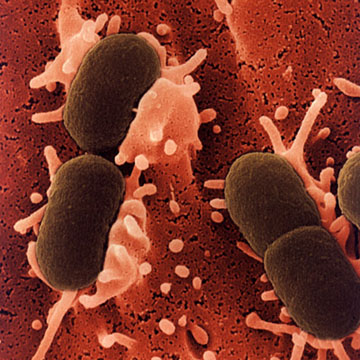Escherichia (E) coli infection and symptoms

What is Escherichia (E.) coli infection
Escherichia (E.) coli - Illness that results from INFECTION with any of the numerous strains of Escherichia coli BACTERIA, some of which are NORMAL FLORA in the human gastrointestinal tract and others that are normal flora in the gastrointestinal tracts of animals consumed as food (such as cattle and poultry). Most strains of E. coli cause mild to moderate illness. Illness from E. coli infection results from the toxins the E. coli release through their normal metabolic functions. The strain E. coli O157:H7, found in beef contaminated with fecal matter, can cause particularly severe illness.
Symptoms of Escherichia (E.) coli infection and Diagnostic Path
The symptoms of common E. coli infection are generally mild to moderate in severity and include
- abdominal cramping
- DIARRHEA
- occasionally NAUSEA and VOMITING
The symptoms of E. coli O157:H7 infection are often more severe and include ABDOMINAL PAIN with profuse, sometimes bloody diarrhea. Though most people recover fully after the illness runs its course in 5 to 10 days, in some people the toxins the E. coli O157:H7 release cause the massive destruction of red BLOOD cells (erythrocytes), a process called HEMOLYSIS. The enormous volume of dead erythrocytes creates proteins in the blood that are damaging to the KIDNEYS, resulting in RENAL FAILURE. The combination of these circumstances is HEMOLYTIC UREMIC SYNDROME (HUS), which occurs as a complication of E. coli O157:H7 infection in about 5 percent of people (mostly children under age 5). HUS nearly always results in END-STAGE RENAL DISEASE (ESRD), requiring dialysis or KIDNEY TRANSPLANTATION.
The diagnostic path for E. coli infection may include culture of stool samples to determine the causative PATHOGEN, though most often doctors do this only when the illness continues beyond about two weeks or has severe symptoms. The doctor must specifically request culture for E. coli O157:H7 as most laboratories do not routinely include this in their testing.
Escherichia (E.) coli: Treatment Options and Outlook
E. coli diarrheal illnesses are very common and nearly all people who acquire them fully recover in three to five days without treatment, except fluid replacement to prevent DEHYDRATION. ANTIBIOTIC MEDICATIONS are seldom appropriate because the cause of symptoms is the toxins the E. coli bacteria release, and killing the bacteria causes them to release even more toxins. It is sometimes helpful to avoid dairy products until bowel activity returns to normal. People who become seriously ill with E. coli O157:H7 may require care in the hospital. Though E. coli O157:H7 infection has gained substantial notoriety, more than 95 percent of people who become ill with it recover without complications.
Risk Factors and Preventive Measures
E. coli infections result from contaminated water or food, especially meats. Swimming in lakes and rivers often exposes people to E. coli contamination; swallowing the water allows the bacteria to enter the gastrointestinal system. Most E. coli infections are FOODBORNE ILLNESSES.
Preventive measures include
- diligent HAND WASHING
- following FOOD SAFETY guidelines for handling and preparing meats and other foods
- thoroughly cooking meats, especially ground beef
Most E. coli infections are preventable.
See also ERYTHROCYTE; WATERBORNE ILLNESSES.
Open discussion on the topic Escherichia (E) coli infection and symptoms
Similar interests
- Casino Non Aams
- Nuovi Casino
- Casinos Not On Gamstop
- UK Casinos Not On Gamstop
- Casinos Not On Gamstop
- UK Casinos Not On Gamstop
- Casino Non Aams Italia
- Slot Sites Not On Gamstop
- Meilleur Casino En Ligne
- Non Gamstop Casino Sites UK
- Meilleur Casino En Ligne
- Casino En Ligne France
- Best Non Gamstop Casinos
- Casinos Not On Gamstop
- UK Casino Not On Gamstop
- Casinos Not Signed Up To Gamstop
- Best Slot Sites UK
- Non Gamstop Casino Sites UK
- Online Casinos Nederland
- Online Casinos Nederland
- Casinos Not On Gamstop
- Best New Uk Casinos Not On Gamstop
- Casino Non Aams
- Non Gamstop Casinos UK
- Migliori Siti Casino Non Aams
- Bitcoin Casinos
- Sites De Paris Sportifs Belgique
- Bookmaker Non Aams
- Casino En Ligne
- Casino Nouveau En Ligne